Source: Carbon Chain Value
Original link: https://mp.weixin.qq.com/s/BlJOGXD2jrwoM_eboz9h0w
Author: Arthur Hayes
Compiled by: Liam
The views expressed in this article represent only the author’s personal views and should not be used as a basis for investment decisions, nor do they constitute any investment advice or trading recommendations.
Equity investors should listen to Yellen: “ Stablecoins , stablecoins, stablecoins; Circle, Circle, Circle.”
Why are they so optimistic? Because Besant's Cock (BBC) said:
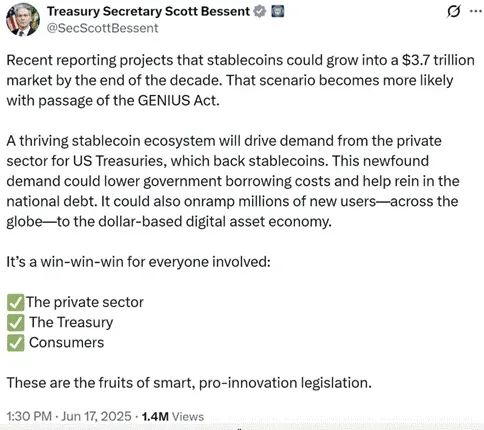
The result is this chart:

This is a comparison of the market capitalizations of Circle and Coinbase. Note that Circle must pay 50% of its net interest income to its parent company, Coinbase. Why is Circle's market capitalization still nearly 45% of Coinbase? This makes one wonder...
Another result is this depressing chart (since I hold Bitcoin and not $CRCL):

This is the ratio of Circle’s price to Bitcoin’s price, indexed to the time Circle went public at 100. Since its IPO, Circle has outperformed Bitcoin by nearly 472%.
Cryptocurrency investors should ask themselves: Why is the BBC so bullish on stablecoins? Why did the Genius Act gain bipartisan support? Do American politicians really care about financial freedom, or is there something else going on? Perhaps politicians do care about financial freedom in the abstract, but high ideals don’t drive action. There must be more realistic political considerations behind the U-turn in stablecoin policy. Back in 2019, Facebook’s attempt to integrate a stablecoin called Libra into its social media empire was aborted due to opposition from politicians and the U.S. Federal Reserve (Fed). Let’s review the main issues that the BBC must address to understand why the BBC is so obsessed with stablecoins.
The main problem facing US Treasury Secretary Scott "BBC" Bessant is the same as that faced by his predecessor Janet "Bad Girl" Yellen. Their bosses like to spend money without raising taxes, namely the President of the United States and the politicians in the House and Senate. Therefore, the Treasury Secretary has to finance the government by borrowing at affordable rates. Soon, the market is unwilling to buy the long-term government bonds of any over-indebted advanced economy at high prices/low yields. This is the "hip sway show" that BBC and Bad Girl Yellen have witnessed in the past few years...hip sway:
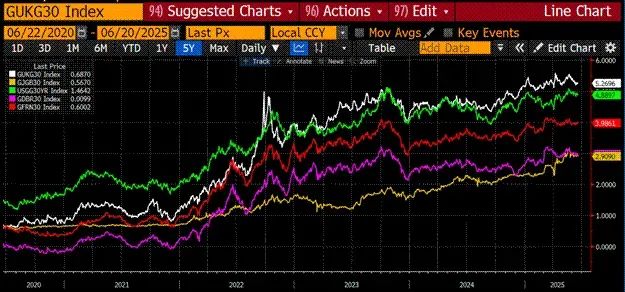
Here are 30-year bond yields for the UK (white), Japan (gold), US (green), Germany (magenta), and France (red).
If rising yields weren't bad enough, the real value of these Treasuries was completely destroyed.
Actual value = Treasury bond price / gold price
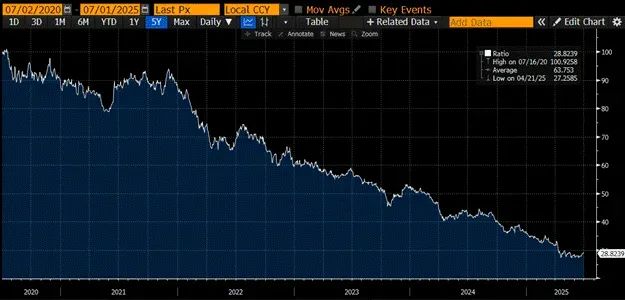
TLT US is an ETF that tracks Treasury bonds with maturities of more than 20 years. TLT US is divided by the gold price and based on 100. Over the past five years, the real value of long-term Treasury bonds has plummeted by 71%.
If past performance wasn’t bad enough, here are the other constraints Yellen and Bessant now face. The Treasury bond sales team must develop an issuance plan that achieves the following goals:
Funding an estimated $2 trillion annual federal deficit and $3.1 trillion in debt due by 2025.


Here is a chart detailing the largest U.S. federal government spending items and their year-over-year changes. Notice how each of the major spending items grew at the same or faster rate than U.S. nominal GDP.
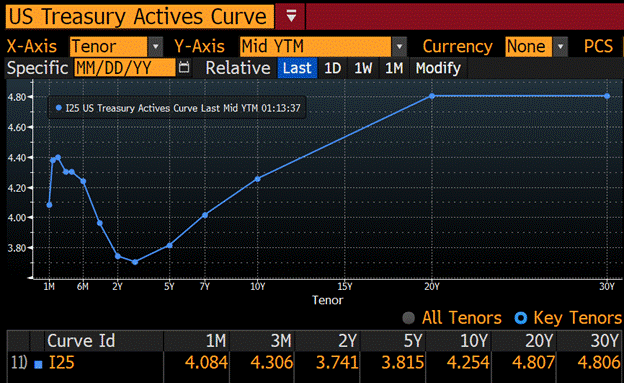
The first two charts show that the weighted average interest rate on outstanding Treasury bonds is lower than anywhere else on the Treasury yield curve.
●The financial system issues credit that is collateralized by nominally risk-free Treasury bonds. Therefore, interest must be paid; otherwise the government will nominally default, which will destroy the entire filthy fiat money financial system. Interest payments will continue to increase as maturing debt will be financed at higher rates because the entire Treasury yield curve is above the weighted average interest rate on current debt.
●The defense budget will not decrease given that the United States is involved in wars in Ukraine and the Middle East.
●Healthcare spending will continue to grow until the early 2030s as baby boomers enter prime age for care provided by Big Pharma, at the expense of the U.S. government.
The bonds are sold in a way that ensures the yield on the benchmark 10-year Treasury bond does not rise above 5%.
●When the 10-year Treasury yield approaches 5%, bond market volatility (measured by the MOVE index) will rise sharply and a financial crisis may follow.
Sell bonds in a way that stimulates broader financial markets.
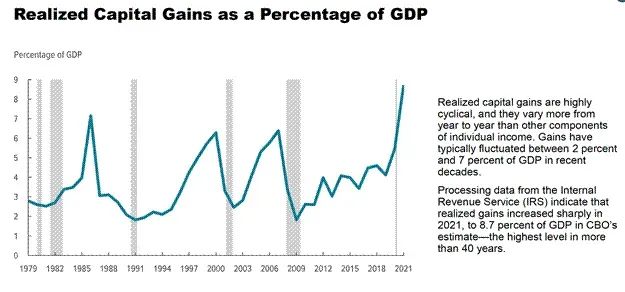
This chart from the Congressional Budget Office only includes data through 2021, but it clearly shows that capital gains tax revenue has surged as U.S. stocks have continued to rise since the global financial crisis in 2008.
●The U.S. government needs to impose an annual tax on stock market gains to prevent incredibly large fiscal deficits.
●The US government exists to serve wealthy property owners. In the “good old days”, when women were in the kitchen, blacks in the fields, and Indians on the frontier, only white male property owners had the right to vote. In modern America, despite universal suffrage, power still derives from the wealth that controls the wealth of public companies, leading to government policies that enrich and consolidate the power of about 10% of households (who control over 90% of stock market wealth). One of the clearest examples of government favoritism toward property owners was during the 2008 Global Financial Crisis (GFC), when the Federal Reserve printed money to save the banks and the entire financial system, but banks were still allowed to foreclose on people’s homes and businesses. The rich enjoy socialism, the poor suffer capitalism! Given this policy record, it’s no surprise that New York mayoral candidate Mamdani is so popular; the poor are just as eager to share in the socialist dividend.
When the Fed was doing quantitative easing (QE), the Treasury secretary had an easy job. The Fed printed money and bought bonds, allowing the U.S. government to expand aggressively with cheap debt and prop up the stock market. But now that the Fed must at least appear to be anti-inflationary, this authority cannot cut rates or do QE. The Treasury has to shoulder the heavy responsibility alone.
By September 2022, the market decided to sell bonds on the belief that the largest peacetime federal deficit in U.S. history would be permanent and the Fed’s hawkish stance. The 10-year Treasury yield nearly doubled in two months, and the stock market fell nearly 20% from its summer highs, and then “bad girl” Yellen put on her red high heels and went into action. In a report from Hudson Bay Capital, Yellen began issuing more non-interest-bearing Treasury bonds instead of interest-bearing Treasury bonds, a policy known as “active Treasury issuance” (ATI). Over the next two years, financial markets were injected with $2.5 trillion as the Fed’s reverse repurchase program (RRP) balance fell. If the goal was to achieve the three goals I mentioned earlier, Yellen’s ATI policy completely achieved the goal. That’s in the past, but what about the BBC? How can he achieve the same goals in the current environment? The RRP is almost exhausted; where will he find trillions of dollars in sterilization funds willing to buy Treasury bonds at high prices and low yields?
The third quarter of 2022 was very difficult. The chart below shows the relationship between the Nasdaq 100 Index (green) and the 10-year Treasury yield (white): When yields soared, stocks fell sharply.

ATI policies have effectively reduced RRP (red) and pushed up financial assets such as the Nasdaq 100 (green) and Bitcoin (magenta). The 10-year Treasury yield (white) has never broken above 5%.
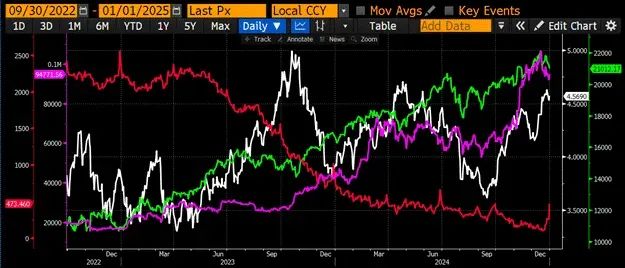
The large “too big to fail” (TBTF) banks hold two pools of money that can be used to buy trillions of dollars of Treasury bonds if there is enough profit margin. These two types of funds are time deposits and reserves held at the Federal Reserve. I focus on these eight TBTF banks because their existence and profitability depend on the government guarantee of their liabilities, and banking regulations are more favorable to them than to non-TBTF banks. Therefore, as long as there is a certain profit margin, they will do what the government asks. The BBC requires them to buy its junk bonds, and in return, the BBC will provide them with a risk-free return.
I think the reason why the BBC is so enthusiastic about "stablecoins" is that by issuing stablecoins, TBTF banks will unlock up to $6.8 trillion in Treasury purchasing power. These interest-free deposits can be re-leveraged in the illusory fiat financial system to support the market. In the next section, I will elaborate on the model of how stablecoin issuance leads to Treasury purchases and improves the profitability of TBTF banks.
After discussing the stablecoin to treasury flows, I will briefly explain that if the Fed stopped paying interest on reserves, it would free up as much as $3.3 trillion to purchase treasuries. This would be another policy that is not technically quantitative easing (QE), but would have the same positive impact on fixed supply monetary assets such as Bitcoin.
Let’s take a look at the BBC’s new favorite currency killer - stablecoins.
Stablecoin Flow
My forecast is based on several key assumptions:
Treasury bonds are fully or partially exempted from the supplementary leverage ratio (SLR)

- Exemption means banks do not need to hold equity capital in their Treasury bond portfolios. Full exemption means banks can buy Treasury bonds with unlimited leverage.
- The Fed just voted to reduce the amount of capital banks need to hold on to Treasuries; the first effects will be felt over the next three to six months. The above chart estimates that this proposal will free up $5.5 trillion in Treasuries buying capacity on banks’ balance sheets. Markets are forward-looking, so this buying power will start to be released in the Treasury market in advance, causing yields to fall (other things being equal).
Banks are profit-seeking, loss-minimizing organizations
● From 2020 to 2022, the Fed and Treasury urged banks to buy large amounts of Treasury bonds; banks bought large amounts of long-term coupon bonds because of their higher yields. By April 2023, losses on these bonds caused three banks to fail in a week as the Fed's policy rate rose at the fastest rate since the early 1980s. In the "too big to fail" field, Bank of America's losses on its maturing bond portfolio exceeded its total equity, and the bank would face bankruptcy if it was forced to mark its bond portfolio to market. To quell the crisis, the Fed and Treasury essentially nationalized the entire US banking system through the Bank Term Funding Program (BTFP). However, non-TBTF banks may still lose money, and if losses on Treasury bonds lead to insolvency, management will be replaced and the bank will be sold to Jamie Dimon or other TBTF banks at extremely low prices. Therefore, bank chief investment officers (CIOs) are cautious about buying large amounts of long-term Treasury bonds, lest the Fed implements a policy of "pulling the rug out" through rate hikes again.
●Banks will buy Treasury bills because they are essentially high-yield, zero-duration, cash-like instruments.
●Banks will use deposits to purchase Treasury bills only when the following conditions are met: when a high net interest margin (NIM) is obtained and when no or only a small amount of capital is required.
JPMorgan Chase recently announced plans to launch a stablecoin called JPMD. JPMD will run on Base, the Ethereum layer 2 network operated by Coinbase. As a result, JPMorgan Chase will have two types of deposits. The first is what I call regular deposits. Regular deposits are still digital, but they require communication between banks through an outdated system and rely on a lot of manual supervision to move within the financial system. Regular deposits are processed from 9 am to 4:30 pm, Monday through Friday. Regular deposits have a very small yield; the Federal Deposit Insurance Corporation (FDIC) estimates that the average yield on regular demand deposits is 0.07%, and the yield on a one-year time deposit is 1.62%.
The second type of deposit is a stablecoin, JPMD. JPMD runs on a public blockchain, in this case Base. Customers can spend JPMD anytime, anywhere (24/7, 365 days). By law, JPMD cannot pay out returns, but I speculate that JPMorgan Chase may entice customers to convert ordinary deposits into JPMD by offering generous cash back spending offers. It is not clear whether staking returns are allowed.
Staking income: When customers lock JPMD in JPMorgan Chase, they can earn income during the period when the stablecoin is locked.
Customers transfer funds from ordinary deposits to JPMD because JPMD is more practical and banks offer cash back consumer benefits. Currently, the total amount of time deposits and demand deposits of large systemically important banks (TBTF) is estimated to be 6.8 trillion US dollars. Since stablecoins are better products, ordinary deposits will be quickly converted to JPMD or other TBTF banks issued similar stablecoins.
Why would JPMorgan Chase go to the trouble of steering customers from regular deposits to JPMD? The first reason is cost cutting. If all regular deposits were converted to JPMD, JPMorgan Chase could essentially eliminate its compliance and operations departments. Let me explain why Jamie Dimon panicked when he learned how stablecoins actually work.
Compliance, at a high level, is a set of rules set by regulators and enforced by a large number of humans using technology from the 1990s. The structure of these rules is: if this happens, then that action is performed. These conditional relationships can be interpreted by a single senior compliance officer and encoded into rules that can be perfectly executed by AI agents. Since JPMD is completely transparent because all public addresses are public, AI agents trained on the relevant corpus of compliance regulations can perfectly ensure that certain transactions will never be approved. The AI can also generate any reports required by regulators instantly. Regulators can verify the accuracy of the data through the public blockchain. Overall, TBTF banks spend $20 billion per year on compliance and related operational technology. By moving all time deposits to stablecoins, this cost will be reduced to almost zero.
The second reason JP Morgan is pushing JPMD is that it enables banks to use managed stablecoin assets (AUC) to purchase billions of dollars of Treasury bonds risk-free. This is because Treasury bonds have almost no interest rate risk, but actually earn the return of the federal funds rate. It should be noted that under the new capital adequacy ratio (SLR) regulations, TBTF banks have $5.5 trillion in Treasury bond purchasing power. Banks need to find a sum of idle cash to purchase the above debt, and their stablecoin holdings are a perfect source of funds.
Some readers may argue that JPMorgan can already buy Treasuries through regular deposits. My response is that stablecoins are the future because they can improve the customer experience and allow TBTF Bank to cut $20 billion in costs. This cost savings alone is enough to motivate banks to adopt stablecoins; the additional net interest margin income is icing on the cake.
I understand that many readers want to throw their hard-earned money into Circle ($CRCL) or the next shiny new stablecoin issuer. But don’t overlook the stablecoin profit potential of TBTF banks. If you multiply the cost savings and stablecoin net interest margin potential by the average TBTF bank P/E ratio of 14.41, you get a figure of $3.91 trillion. The total market cap of the eight TBTF banks is currently around $2.1 trillion, which means that stablecoins could increase TBTF bank stock prices by an average of 184%. If there is a non-consensus trading opportunity that investors can execute at scale, it is to buy a basket of TBTF bank stocks in an equal-weighted allocation based on the stablecoin thesis.

So what about competition?
No need to worry; the Genius Act ensures that non-bank-issued stablecoins cannot compete on a large scale. The bill explicitly prohibits tech companies like Meta from issuing their own stablecoins, and they must partner with banks or fintechs. Of course, in theory any entity can apply for a banking license or acquire an existing bank, but all new owners must be approved by regulators. Let's see how long this takes. Another provision that cedes the stablecoin market to banks is the prohibition on paying interest to stablecoin holders. Unable to compete by paying interest to holders, fintechs will not be able to siphon deposits from banks at a low cost. Even a successful issuer like Circle will never be able to touch the $6.8 trillion in ordinary deposits at TBTF banks. In addition, fintechs like Circle and small banks do not enjoy government guarantees on their liabilities, while TBTF banks do. If my mother were to use a stablecoin, she would definitely choose a stablecoin issued by a TBTF bank. Baby boomers like her would never use a stablecoin from a fintech or small bank because they don't trust these institutions and believe they lack government guarantees.
David Sachs, a cryptocurrency advisor to US President Trump, shares the same view. I believe many corporate donors who donated to the cryptocurrency industry are unhappy that after investing a lot of cryptocurrency campaign donations, they were quietly excluded from the lucrative US stablecoin market. Perhaps they should change their strategy and truly advocate for true financial freedom instead of just providing a toilet seat for TBTF bank CEOs to defecate.
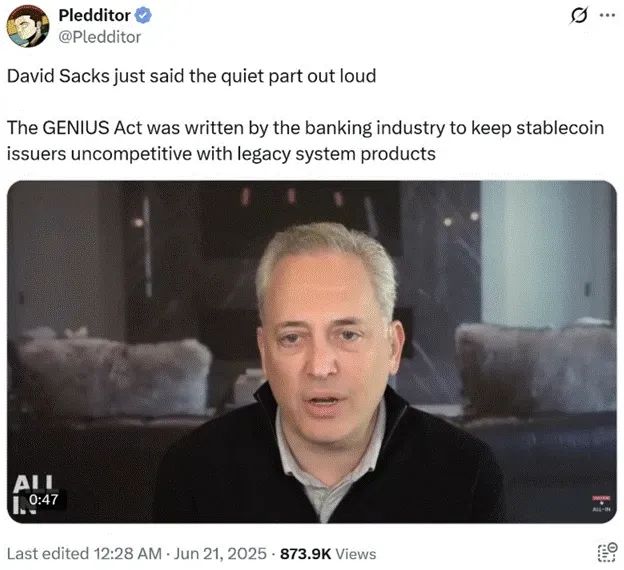
In short, the adoption of stablecoins by large banks eliminates competition from fintechs for their deposit base, reduces reliance on expensive and often incompetent compliance staff, eliminates the need to pay interest, and thus boosts net interest margins (NIMs), ultimately driving up stock prices. In return for the BBC’s gift of stablecoins, large banks will purchase up to $6.8 trillion in Treasury bonds.
ATI: Bad Girl Yellen: Stablecoins: BBC
Next, I explore how the BBC could free up an additional $3.3 trillion of idle reserves from the Fed’s balance sheet.
Interest Rate on Reserves (IORB)
After the 2008 Global Financial Crisis (GFC), the Fed decided that banks would not fail for lack of reserves. The Fed created reserves by buying Treasury bonds and mortgage-backed securities held by banks, which sat idle on the Fed's balance sheet, a process known as quantitative easing. In theory, banks could convert reserves deposited with the Fed into currency in circulation and use it for lending, but they chose not to because the Fed would pay enough interest by printing money. The Fed prevented inflation from surging further by "sterilizing". The problem for the Fed is that as interest rates rise, so does the interest on reserves (IORB). This is not good for the Fed because the unrealized losses on its bond portfolio also increase with rising interest rates. As a result, the Fed is effectively insolvent and cash flow negative. However, this negative cash flow situation is purely a policy choice and can be adjusted at any time.

US Senator Ted Cruz recently suggested that perhaps the Fed should stop paying IORB. This would force banks to make up for the lost interest income by converting reserves into Treasury securities. Specifically, I think they would buy Treasury bills for their high yield and cash-like properties.
Senator Cruz has been urging his Senate colleagues to end the Fed’s power to pay banks for reserves, a move he believes would be an important step in reducing the deficit. – Source: Reuters
Why is the Fed printing money and preventing banks from supporting this empire? There is no reason for politicians to oppose this policy adjustment. Both Democrats and Republicans love fiscal deficits; why not allow themselves to increase spending by releasing the banks' $3.3 trillion of purchasing power into the Treasury market? Given the Fed's unwillingness to help the Trump team finance its "America First" policies, I think Republican lawmakers will use their majorities in both houses to strip the Fed of this power. So the next time yields spike, lawmakers will be ready to release this flood of money to finance their wanton spending.
I conclude this article with my optimism that USD liquidity will inevitably increase during the BBC’s tenure, but I want to first address Maelstrom’s cautious stance during the current to third quarter period.
A cautionary tale
Although I am very optimistic, I think there may be a brief pause in USD liquidity creation after the passage of Trump’s spending bill (the “Big and Beautiful Act”).
The bill currently includes a debt ceiling increase. Although many provisions will be bargained over between politicians, Trump will not sign a bill that does not raise the debt ceiling. He needs additional borrowing capacity to finance his agenda. There is no sign that Republicans will try to force the government to cut spending. What traders need to pay attention to is how will the dollar liquidity be affected when the Treasury resumes net borrowing?
Since January 1, the Treasury has been funding the government primarily by drawing on its checking account (the Treasury General Account, or TGA). As of June 25, the TGA balance was $364 billion. Based on the Treasury's guidance in its latest quarterly refinancing announcement, if the debt ceiling is raised today, the TGA balance will be replenished to $850 billion through debt issuance. This will result in a $486 billion contraction in U.S. dollar liquidity. The only significant U.S. dollar liquidity item that could mitigate the negative shock is if funds flow out of repurchase agreements (RRPs), which currently stand at $461 billion.
This is not a clear-cut short trade opportunity for Bitcoin as the TGA replenishment is uncertain. Caution is advised at this point as the bull market could be disrupted in the short term. I think the market will trade sideways or slightly down between now and August when Jerome Powell speaks at Jackson Hole. If the TGA replenishment proves to be a negative for USD liquidity, the downside target is $90,000 to $95,000. If the replenishment turns out to be insignificant, Bitcoin will be range bound in the $100,000 range and struggle to break the all-time high of $112,000. I feel like Powell will announce an end to quantitative tightening and/or roll out some seemingly mundane but significant banking regulatory reforms. By early September, the debt ceiling will be raised, the TGA will be mostly replenished, and Republicans will focus on distributing benefits to avoid being abandoned by voters in the November 2026 election. A green cross driven by a surge in money supply will then pierce the bears.
Maelstrom will be overweight USDe (Ethena USD) by the end of August. We have liquidated all illiquid shit coin positions. Depending on price action, we may lighten our Bitcoin exposure modestly. Buying shit coin exposure around April 9th, earned 2x to 4x returns on a select few shit coin in three months. In the absence of a clear liquidity catalyst, the shit coin market will be hit hard. In the subsequent stages, we can confidently buy the dips in shit coin and perhaps capture 5x or 10x gains before fiat liquidity creation slows again in late Q4 2025 or early Q1 2026.
Check the points
The adoption of stablecoins by major banks would create up to $6.8 trillion in purchasing power for Treasury bonds.
The Federal Reserve’s cessation of paying the interest on excess reserves (IORB) would free up as much as $3.3 trillion in purchasing power for Treasury bonds.
$10.1 trillion may gradually pour into the Treasury market due to BBC policy. If my prediction is correct, this $10.1 trillion liquidity injection will have the same impact on risk assets as Yellen's $2.5 trillion injection... Make the market boil!
This is another liquidity arrow in the BBC's policy toolbox that can be pulled out at any time. Once Trump's "Big, Beautiful Bill" is passed and the debt ceiling is raised, this arrow will be activated. Then investors will once again worry about how the Treasury can absorb the large amount of debt that will be issued without causing a crash.

Some of you are still waiting for the monetary policy gods. You are waiting for Fed Chairman Powell to announce another round of unlimited quantitative easing and rate cuts before you sell your bonds and buy crypto. It is not going to happen, at least not until the United States is clearly at war with Russia, China, and/or Iran, or until large systemically important financial institutions are on the verge of collapse. Not even a recession can make the monetary policy gods appear. So stop listening to the fools in the "weak" positions and start listening to the one who holds the "Big Mac".
The next few charts will show the opportunity cost that investors pay while waiting for the monetary policy "magic".
The Fed's balance sheet (white) has fallen while the effective federal funds rate (gold) has risen. You might expect Bitcoin and other risk assets to fall sharply during this period.
Bad girl Yellen won’t let the rich down, she implemented the asset purchase program (ATI). Bitcoin (gold) rose 5 times during the same period, while repurchase agreement (RRP) balances fell 95%.
Don’t make the same mistake again. Many financial advisors are still urging clients to buy bonds because yields are predicted to fall. I agree that global central banks will cut rates and print money to prevent a collapse in government bond markets. Moreover, if central banks don’t act, the Treasury will. This is the argument I make in this article; I think Bessent could free up up to $10.1 trillion in Treasury buying power by supporting stablecoin regulation, removing the SLR exemption, and stopping paying negative interest rates (IORB). But who cares if you get a 5% or 10% return on your bonds? You’ll miss out on Bitcoin skyrocketing 10x to $1 million, or the Nasdaq 100 surging 5x to 100,000 by 2028.
The real stablecoin layout is not to bet on old fintech companies like Circle, but to understand that the US government has handed the key to the launch of trillions of dollars of liquidity bazooka to the "too big to fail" banks in the name of "innovation". This is not decentralized finance (DeFi). This is not financial freedom. This is debt monetization in the guise of Ethereum. If you are still waiting for Powell to whisper "unlimited quantitative easing" in your ear before you dare to take risks, congratulations - you are a victim of the withdrawal of liquidity.
Instead, long Bitcoin. Long JPMorgan. Forget Circle. The stablecoin Trojan horse has already infiltrated the fortress, and when it opens, it is not with libertarian dreams, but filled with treasury-buying liquidity designed to sustain stock market bubbles, finance deficits, and paralyze the baby boomers. Don’t sit on the sidelines waiting for Powell to bless the bull market. The BBC has stopped touting, it’s time for him to conquer the world with his liquidity juice.








